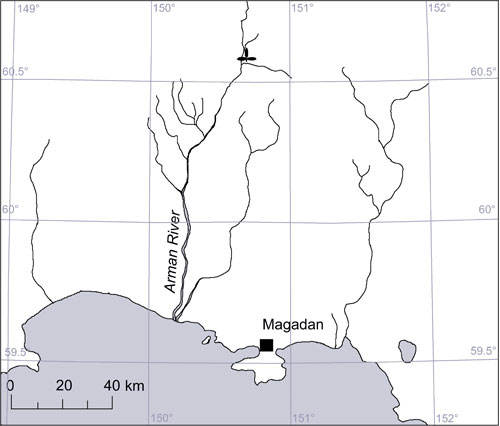Arman River
| Geology | Fossil Flora | NE Russia Map | Fossil Images |
|---|
The Arman’ Formation is exposed along the middle reaches of the Arman River in Magadan District, NE Russia. It is composed of volcanicalstics and sedimentary rocks that have yielded a diverse flora (see sedimentary log in the panel to the right). In the Nel’kandzha and Khasyn river basins (right bank of the Khasyn River near the Karamken inclusive), approximately the same stratigraphic interval made up of interlayered plant-bearing volcanogenic sedimentary strata and volcanics of predominantly intermediate composition is known as the Naraula Formation. The Naraula Formation is overlain by silicic volcanics of the Khol’chan Formation, and is stratigraphically higher than the sedimentary beds of the Kirik Sequence containing Albian plant remains of the Buor'Kemuss type (Herman et al., 2016). Stratigraphic relations between the Arman’ and Naraula formations are as yet unclear. Both formations may be facies analogs, but another possibility is that The Arman overlies the Naraula. In the stratotype area at the Arman’ River (downstream off the village Madaun), the Arman’ Formation includes three successions ranked as subformations by some researchers. These are (from the base upward) argillite sandstone (up to 1100 m thick), sandstone conglomerate (500 m), and sedimentary volcanogenic (400 m) successions (Shchepetov, 1995). It is these rocks that contain diverse plant fossils which are mostly confined to argillite sandstone facies. In addition, plant remains have been collected from the Naraula Formation in the Nel’kandzha–Khasyn interfluve. The age of the Arman’ Flora has been a subject of lively debate. Popova (1959) argued for this flora ranging from the Cenomanian to Senonian. However Efimova (1957) regarded it to be Cenomanian – Turonian. Samylina (1974, 1976) who favoured a late Albian age of the Arman’ Flora did concede that it may extend into part of the Cenomanian. It was also her opinion that in Northeast Russia the Arman’ Flora gave rise to the Cenomanian Arkagala Flora and then to the late Cenomanian - early Turonian Grebenka Flora. Lebedev (1987) and Belyi (1997a, 1997b, 2003) shared this viewpoint on the age and succession of these floras. Filippova insisted however that the Arman’ and Grebenka floras are concurrent, corresponding in age either to the Cenomanian (Filippova, 1975a; Filippova and Abaramova, 1993) or to the late Albian – early Turonian (Filippova, 2006). In a later work (Filippova, 2009), she concluded that the Arman’ Flora is of Cenomanian – middle Turonian age. In contrast to those who regarded the flora as falling into the late Albian to Turonian interval Herman (2004, 2005) argued that the frequent occurrence of plant remains characteristic of the Late Cretaceous floras in Northeast Russia, namely of conifers Cephalotaxopsis, Sequoia, and diverse angiosperms suggested a Turonian - Coniacian age. Angiosperm taxa such as Menispermites ex gr. septentrionalis, M. sibiricus, Dalembia pergamentii, Terechovia intermedia, Ziziphoides smilacifolia, platanoids Paraprotophyllum cf. cordatum, Pseudoprotophyllum ex gr. boreale, Arthollia pacifica, and species Trochodendroides, Araliaephyllum, Myrtophyllum, and Cissites suggest a similarity between the Arman’, Penzhina (Turonian), and Kaivayam (Coniacian) floras of Northwest Kamchatka (Herman, 1999), and with the Tyl’pegyrgynai Flora (early Coniacian) of the Pekul’nei Ridge (Filippova and Abramova, 1993; Herman, 1999; Filippova, 2005). Critically the ages of the Penzhina, Kaivayam, and Tyl’pegyrgynai floras are reliably determined based on correlation with marine deposits. Isotopic dating for volcanics of the Okhotsk – Chukotka volcanogenic belt has not been without its critics (Kotlyar and Rusakova, 2004; Belyi, 2008). However the 40Ar/39Ar (monomineral fractions) and U–Pb SHRIMP (zircons) dates seem to be sufficiently reliable for age determination (Tikhomirov et al., 2006; Filatova, 2008) as they are less prone to chemical alteration than other systems. Now 40Ar/39Ar dates of 86 ± 1, 85.6 ± 1.3, and 85.5 ± 1.1 Ma (the terminal Coniacian – initial Santonian) have been obtained for volcanics of the Naraula Formation (Akinin and Hourigan, 2002; Hourigan and Akinin, 2004). Akinin (2007) also dated the detrital zircons from volcanogenic sedimentary deposits of the Arman’ Formation stratotype on the left bank of the river. Among the U–Pb (SHRIMP) dates based on 25 zircon crystals from a sandstone sample with a plant impression, the youngest age obtained was 92 ± 2 Ma, thus suggesting a Turonian age for the studied sample “and of the Arman’ floristic assemblage respectively” (Akinin, 2007, p. 20). Thus, isotopic dating of plant-bearing rocks from the Arman’ and Naraula formations give a Turonian – Coniacian age, which is consistent with the floral composition.
Field photograph of the Arman River Valley taken from near the plant fossil locality. The lower sedimentary log (right) represents part of a large fluvial channel exposed approximatley 100m downstrean from the upper section. Approximately 10 m below the upper sedimentary log (right) Equisetites, Birisia, Sequoia (minuta?) and a trilobed angiosperm (Araliaephyllum?) fragment were recovered. Desmiophyllum magnum and Podozamites were found on a loose block near this section. Overlying the section represented in the upper sedimentary log is a succession of silty shales, sandstones and conglomerates, apparently lacking pyroclastics. Coarser sands with basal pebble lags, cross-bedding and load structures preserved abundant, sometimes orientated branchwood. Betwteen the sands carbonaceous shales and mudstones preserved abundant Podozamites. The whole succession is interpreted to represent episodic high energy sedimentation in a rapidly subsiding basin. After each influx of sediment the sub-aerial sediment surface was stable long enough to become densley forested before the next deepening event and pulsed sediment influx. |
Map showing the position of the Arman flora locality at 60.56511°N, 150.653799°E.
Representative sedimentary log of part of the Arman River section drawn by Anders Ahlberg in July 1997. Floodplain lake, crevasse splay and sub-aerial vegetated floodplain environments are all represented. This section overlies the fluvial sediments shown below and is exposed approximately 100m upstream from them.
Representative sedimentary log of part of the Arman River section drawn by Anders Ahlberg in July 1997 showing a succession of fluvial channel fills. |




